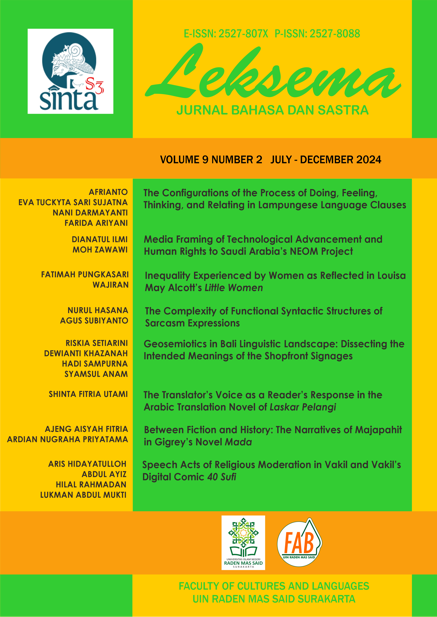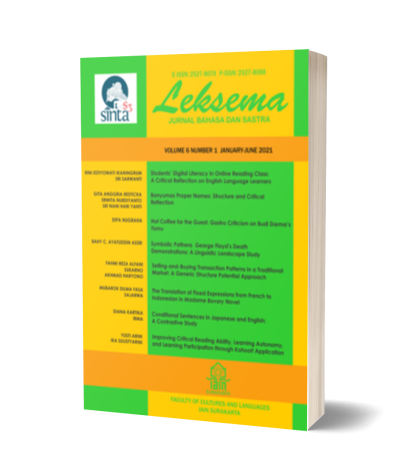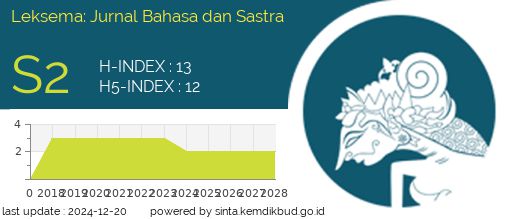GEOSEMIOTICS IN BALI LINGUISTIC LANDSCAPE: DISSECTING THE INTENDED MEANINGS OF THE SHOPFRONT SIGNAGES
DOI:
https://doi.org/10.22515/ljbs.v9i2.9062Keywords:
Bali, English, geosemiotics, linguistic landscape, signageAbstract
This article investigates salient components in Bali shopfront signages to discover the intended meanings behind the use of the signs and the use of English and its counterparts, in particular local/national languages, in them. Two approaches employed are geosemiotics–to construe the meanings of the signs–and linguistic landscape–to reveal the role of English and its counterparts in them. Bali, specifically Kuta was selected as the most affluent tourism area and is chosen due to the fact that it experiences the apparent change in its linguistic landscape. The former approach covers three prominent elements, such as interaction order, visual semiotics, and place semiotics, conceiving the whole message the sign makers convey. Meanwhile, the latter focuses on the revelation of the visibility of English and the local and national languages in the signages and the revelation of their implied meaning. The collected data are 10 signages, as these are most representative data to select, in terms of the outright blends of English and its counterparts. The result of the analysis indicates some facts conceiving interaction, visual and situational meanings. English was mostly found in the type of businesses, the offers and products, and slogan. The visibility of English along with local/national languages and their influence in all selected data indicates modernity, efficiency and effectiveness, luxury, being communicative, non-traditional manner, and happy-go-lucky sense. The Indonesian and local languages are reported to be used as the names of the shop, and as referring to either low-budget or affordable prices of products or culturally/locally bound reason.
Downloads
References
Aini, Anita Nur, Yarno Yarno, and R Panji Hermoyo. 2023. “Lanskap Linguistik di Stasiun Surabaya Pasarturi”. Diglosia: Jurnal Kajian Bahasa, Sastra, dan Pengajarannya 6 (3): 795–814. DOI:10.30872/diglosia.v6i3.691.
Alhaider, Siham Mousa. 2023. “Linguistic Landscape of Arabs in New York City: Application of a Geosemiotics Analysis”. ISPRS International Journal of Geo-Information 12 (5): 1-19. DOI:10.3390/ijgi12050192.
Alomoush, Omar Ibrahim Salameh. 2019. “English in the Linguistic Landscape of a Northern Jordanian City”. English Today 35 (3): 35–41. DOI:10.1017/S0266078418000391.
Andriyanti, Erna. 2021. “Social Meanings in School Linguistic Landscape: A Geosemiotic Approach”. Kemanusiaan 28 (2): 105–134. DOI:10.21315/KAJH2021.28.2.5.
Backhaus, Peter. 2006. “Multilingualism in Tokyo: A Look into the Linguistic Landscape.” International Journal of Multilingualism 3 (1): 52–66.
Ben-Rafael, Eliezer, Elana Shohamy, Muhammad Hasan Amara, and Nira Trumper-Hecht. 2006. “Linguistic Landscape as Symbolic Construction of the Public Space: The Case of Israel”. International Journal of Multilingualism 3 (1): 7–30. DOI:10.1080/ 14790710608668383.
Cenoz, Jasone and Durk Gorter. 2011. "Multilingualism". In James Simpson (ed.). The Routledge Handbook of Applied Linguistics (First Edition). Routledge.
da Silva, Anna Marietta and Deny Arnos Kwary. 2012. "Identity Construction of Places through Translanguaging in Jakarta: A Linguistic Landscape oif Gambir Train Station". Journal of Belonging, Identity, Language, and Diversity (J-BILD) 6 (2): 8–25
da Silva, Anna Marietta, Yassir Nasanius Tjung, Sri Hapsari Wijayanti, and Christiany Suwartono. 2022. “Language Use and Tourism in Yogyakarta; The Linguistic Landscape of Malioboro”. Wacana: Journal of the Humanities of Indonesia 22 (2): 295-318. DOI: 10.17510/wacana.v22i2.721.
Drori, Gili S, Markus A Höllerer, and Peter Walgenbach. 2014. "Unpacking the Glocalization of Organization: From Term, to Theory, to Analysis". European Journal of Cultural and Political Sociology 1 (1): 85–99.
Ganesan, Dinesh Kumar. 2024. “A Geosemiotic Analysis of Mangala’s “Air Mail””. In NC Vethambal (ed.). World of Words: Space and Place in Contemporary Narratives. White Falcon Publishing
Heryanto, Ariel. 2016. "Engdonesian". arielheryanto.com. March 4. https://arielheryanto.com/ 2016/03/04/engdonesian/. Accessed November 18, 2024.
Kachru, Braj B. 1992. “World Englishes: Approaches, Issues and Resources”. Language Teaching: Surveys and Studies 25 (1): 1-14. DOI:10.1017/S0261444800006583.
Fekede, Alemayehu and Wondowsen Tesfaye. 2020. “Multilingual Practices and Multiple Contestations in the Linguistic Landscape of Selected Towns in Oromia: A Geosemiotic Perspective”. Macrolinguistics 8 (12): 105–124. DOI:10.26478/ja2020.8.12.7.
Khazanah, Dewianti and Reni Kusumaningputri. 2021. “Unpacking Multilingualism in Tourism Peripheries in Bali: Taking a Look into Private Shop-Fronts”. K@ta 23 (1): 28–37. DOI:10.9744/kata.23.1.28-37.
Khazanah, Dewianti, Hadi Sampurna, Reni Kusumaningputri, Riskia Setiarini, and Supiastutik. 2021. “A Linguistic Landscape Study of English in Yogyakarta: Its Representation of Power in Commercial Boards”. ELLITE: Journal of English Language, Literature, and Teaching 6 (2): 92–102. DOI:10.32528/ellite.v6i2.6380.
Khazanah, Dewianti, Reni Kusumaningputri, Riskia Setiarini, Syamsul Anam, and Hadi Sampurna. 2022. “English in Shop Signs: Exploring the Bilingual Creativities Found in the Tourism Landscape in Malang and Batu”. New Language Dimensions 3 (1): 38–49. https://journal.unesa.ac.id/index.php/nld/index.
Khazanah, Dewianti, Reni Kusumaningputri, Hadi Sampurna, Riskia Setiarini, and Syamsul Anam. 2023. “The ‘Face’ of Indonesian Cosmetics: Investigating Language Choices in Local Brand Advertisement Boards and Consumers’ Preferences.” Indonesian Journal of EFL and Linguistics 8 (1): 55–66. DOI:10.21462/ijefl.v8i1.579.
Kim, Tae Sik. 2024. “The Geosemiotics of Urban Transnationalism: A Case Study of Vietnamese Commercial Landscapes in Prague”. City 28 (3–4): 400–418. DOI:10.1080/13604813.2024.2377917.
Kress, Gunther and Theo van Leeuwen. 2006. Reading Images: The Grammar of Visual Design. (2nd edition). Routledge.
Landry, Rodrigue and Richard Y Bourhis. 1997. “Linguistic Landscape and Ethnolinguistic Vitality: An Empirical Study”. Journal of Language and Social Psychology 16 (1): 23–49.
Lanza, Elizabeth and Hirut Woldemariam. 2014. “Indexing Modernity: English and Branding in the Linguistic Landscape of Addis Ababa”. International Journal of Bilingualism 18 (5): 491–506. DOI:10.1177/1367006913484204.
Lavender, Jordan. 2020. “English in Ecuador: A Look into the Linguistic Landscape of Azogues”. Journal of Multilingual and Multicultural Development 41 (5): 383–405. DOI:10.1080/01434632.2019.1667362.
Lee, Jamie Shinhee. 2019. “Multilingual Advertising in the Linguistic Landscape of Seoul”. World Englishes 38 (3): 500–518. DOI:10.1111/weng.12427.
Liao, Jian, Xiaofei Lu, Katherine A Masters, and Zhi Zhou. 2024. “Meaning-Focused Foreign Language Instruction via Telepresence Robots: A Geosemiotic Analysis”. ReCALL 36 (2): 168-186. DOI:10.1017/S095834402400003X.
Lou, Jackie Jia. 2017. “Spaces of Consumption and Senses of Place: A Geosemiotic Analysis of Three Markets in Hong Kong.” Social Semiotics 27 (4): 513–531. DOI:10.1080/10350330.2017.1334403.
Lowenberg, Peter H. 1991. “English as an Additional Language in Indonesia”. World Englishes 10 (2): 127-138. DOI:10.1111/j.1467-971X.1991.tb00146.x.
Lu, Xing, I Nengah Sudipa, I Ketut Artawa, and Made Suastra. 2021. “The Linguistic Landscape of Dali Ancient City, China: A Geosemiotics Approach”. The International Journal of Language and Cultural (TIJOLAC) 3 (1): 46-55. DOI:10.5281/zenodo.4707337.
Nikolaou, Alexander. 2017. “Mapping the Linguistic Landscape of Athens: The Case of Shop Signs”. International Journal of Multilingualism 14 (2): 160–82. DOI:10.1080/14790718.2016.1159209.
Paramarta, I Made Suta, Ketut Artawa, Made Sri Satyawati, Ketut Widya Purnawati, and Made Aryawan
Adijaya. 2023. “Geosemiotic Analysis of Commercial Outdoor Signs in North Bali Urban Area, Indonesia”. Kasetsart Journal of Social Sciences 44 (3): 965–974. DOI: 10.34044/j.kjss.2023.44.3.35.
Parker, Steph. 2021. "Why a Sarong Is the Ultimate Travel Item". Big World Small Pockets. https://www.bigworldsmallpockets.com/sarong-travelling/. Accessed November 11, 2023.
Sadiq, Nizamuddin. 2024. "(Inter)nationalisation at Home: A Geosemiotic Analysis of the Bilingual Linguistic Schoolscape of a Private Islamic-Based National University in Yogyakarta, Indonesia." Linguistik Indonesia 42 (2): 296–312.
Sampurna, Hadi, Riskia Setiarini, Dewianti Khazanah, Reni Kusumaningputri, and Syamsul Anam. 2023. “Why Is so English in Indonesian Cosmetics Advertisements?: Deciphering the Commodification of English”. Jurnal Sinestesia. 13 (2): 1361–1373. https://sinestesia.pustaka. my.id/journal/article/view/445.
Scollon, Ron and Suzie Wong Scollon. 2003. “Discourses in Place: Language in the Material World”. Routledge. DOI:10.4324/9780203422724.
Stevenson, Sacha. 2018. “Englonesian, Bahasa untuk si Kurang Paham Inggris dan Indonesia”. Kumparan. September 17. https://kumparan.com/sacha-stevenson/englonesian-bahasa-untuk-si-kurang-paham-inggris-dan-indonesia1pYLCd ZVFGG.
Tafrijiyah, Kaamilah, Lisa Nur Chasanah, Nanang Syaifudin, and Cindy Andriani. 2024. “A Linguistic Landscape Study into Bakery Signs: A Case of Yogyakarta”. International Journal of Society, Culture & Language 12 (3): 108-119. https://doi.org/10.22034/ ijscl. 2024.2035703.3571.
Wang, Jing Jing. 2021. “Geosemiotic Analysis of Signs in the Linguistic Cityscape of China”. International Journal of Language and Linguistics 9 (4): 226–232. doi:10.11648/ j.ijll.20210904.23.
Williams, Allan M and C. Michael Hall. 2000. "Tourism and Migration: New Relationships between Production and Consumption." Tourism Geographies 2 (1): 5–27.
Downloads
Published
Issue
Section
License
Copyright (c) 2024 Leksema: Jurnal Bahasa dan Sastra

This work is licensed under a Creative Commons Attribution-NonCommercial-ShareAlike 4.0 International License.
The copyright of the received article shall be assigned to the publisher of the journal. The intended copyright includes the right to publish the article in various forms (including reprints). The journal maintains the publishing rights to published articles.
In line with the license, the authors and users (readers or other researchers) are allowed to share and adapt the material only for non-commercial purposes. In addition, the material must be given appropriate credit, provided with a link to the license, and indicated if changes were made. If authors remix, transform or build upon the material, authors must distribute their contributions under the same license as the original.







